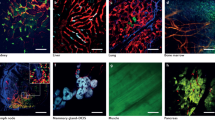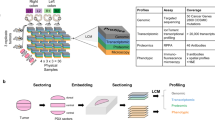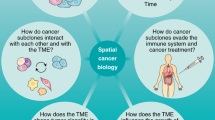Key Points
-
Traditional approaches of monitoring cancer growth in mouse models have largely used surface-implanted tumours and caliper measurements.
-
A variety of non-invasive high-resolution imaging methods are now available for the detection and monitoring of deep-seated cancers, as well as their metastases, in transgenic models.
-
Magnetic resonance imaging (MRI) and computed tomography (CT) are primarily used to display internal anatomy of mouse models and are useful tools for phenotyping.
-
The availability of radioisotope, magnetic and/or fluorescent tags is continuously improving our ability to image specific molecular markers in vivo.
-
The use of 'smart' sensors for MRI and optical imaging holds particular promise in sensing and reporting molecular signatures.
-
Technologies are being developed that will ultimately allow cellular protein and signal-pathway profiling. This will further extend our understanding of the molecular pathology of cancer, speed up drug development and can lead to patient-tailored therapies.
Abstract
The development of miniaturized imaging equipment and reporter probes has improved our ability to study animal models of disease, such as transgenic and knockout mice. These technologies can now be used to continuously monitor in vivo tumour development, the effects of therapeutics on individual populations of cells, or even specific molecules. If these techniques prove effective in mice, they might be translated into the clinic in the future, where they could be used to non-invasively detect and monitor treatment of human cancers.
This is a preview of subscription content, access via your institution
Access options
Subscribe to this journal
Receive 12 print issues and online access
$209.00 per year
only $17.42 per issue
Buy this article
- Purchase on Springer Link
- Instant access to full article PDF
Prices may be subject to local taxes which are calculated during checkout



Similar content being viewed by others
References
DePinho, R. A. The age of cancer. Nature 408, 248–254 (2000).
Attardi, L. D. & Jacks, T. The role of p53 in tumour suppression: lessons from mouse models. Cell. Mol. Life Sci. 55, 48–63 (1999).
Artandi, S. et al. Telomere dysfunction promotes non-reciprocal translocations and epithelial cancers in mice. Nature 406, 641–645 (2000).
Gillies, R. et al. Applications of magnetic resonance in model systems: tumor biology and physiology. Neoplasia 2, 139–151 (2000).
Lewin, M. et al. In vivo assessment of vascular endothelial growth factor-induced angiogenesis. Int. J. Cancer 83, 798–802 (1999).
Taylor, J. S. et al. MR imaging of tumor microcirculation: promise for the new millennium. J. Magn. Reson. Imaging 10, 903–907 (1999).
Weissleder, R., Cheng, H., Marecos, E., Kwong, K. & Bogdanov, A. Mapping of tumor vascular and interstitial volume fractions non-invasively in vivo. Eur. J. Cancer 34, 1448–1454 (1998).
Mandeville, J. B. et al. Dynamic functional imaging of relative cerebral blood volume during rat forepaw stimulation. Magn. Reson. Med. 39, 615–624 (1998).
Neeman, M., Dafni, H., Bukhari, O., Braun, R. D. & Dewhirst, M. W. In vivo BOLD contrast MRI mapping of subcutaneous vascular function and maturation: validation by intravital microscopy. Magn. Reson. Med. 45, 887–898 (2001).
Brasch, R. et al. Assessing tumor angiogenesis using macromolecular MR imaging contrast media. J. Magn. Reson. Imaging 7, 68–74 (1997).
Dennie, J. et al. NMR imaging of changes in vascular morphology due to tumor angiogenesis. Magn. Reson. Med. 40, 793–799 (1998).
Koutcher, J. A., Zakian, K. & Hricak, H. Magnetic resonance spectroscopic studies of the prostate. Mol. Urol. 4, 143–152; discussion 153 (2000).
Sipkins, D. A. et al. Detection of tumor angiogenesis in vivo by αVβ3-targeted magnetic resonance imaging. Nature Med. 4, 623–626 (1998).
Bogdanov, A., Matuszewski, L., Bremer, C., Petrovsky, A. & Weissleder, R. Oligomerization of paramagnetic substrates result in signal amplification and can be used for MR imaging of molecular targets. Mol. Imaging 1, 1–9 (2001).
Weissleder, R. et al. In vivo magnetic resonance imaging of transgene expression. Nature Med. 6, 351–355 (2000).
Josephson, L., Perez, M. & Weissleder, R. Magnetic nanosensors for the detection of oligonucleotide sequences. Angew. Chem. (Int Ed.Engl.) 40, 3204–3206 (2001).Describes the use of magnetic nanoparticles as sensors to read out DNA hybdridization and, potentially, interactions between large and small molecules. Similar nanoparticles are also used for imaging of other molecular targets by high-resolution MRI.
Lewin, M. et al. Tat peptide-derivatized magnetic nanoparticles allow in vivo tracking and recovery of progenitor cells. Nature Biotechnol. 18, 410–414 (2000).Describes a versatile magnetic label that can be used to image a variety of cell types in vivo . Labelled cells were isolated after intravenous injection using a magnetic separation column.
Kennel, S. J. et al. High resolution computed tomography and MRI for monitoring lung tumor growth in mice undergoing radioimmunotherapy: correlation with histology. Med. Phys. 27, 1101–1107 (2000).
Borah, B. et al. Three-dimensional microimaging (MRmicroI and microCT), finite element modeling, and rapid prototyping provide unique insights into bone architecture in osteoporosis. Anat. Rec. 265, 101–110 (2001).
Paulus, M. J., Gleason, S. S., Kennel, S. J., Hunsicker, P. R. & Johnson, D. K. High resolution X-ray computed tomography: an emerging tool for small animal cancer research. Neoplasia 2, 62–70 (2000).
Paulus, M. J., Gleason, S. S., Easterly, M. E. & Foltz, C. J. A review of high-resolution X-ray computed tomography and other imaging modalities for small animal research. Lab. Anim. (NY) 30, 36–45 (2001).
Turnbull, D. et al. Ultrasound backscatter microscope analysis of mouse melanoma progression. Ultrasound Med. Biol. 22, 845–853 (1996).
Rooks, V., Beecken, W., Iordanescu, I. & Taylor, J. A. Sonographic evaluation of orthopic bladder tumors in mice treated with TNP-470, an angiogenesis inhibitor. Acad. Radiol. 8, 121–127 (2001).
Drevs, J. et al. Effects of PTK787/ZK 222584, a specific inhibitor of vascular endothelial growth factor receptor tyrosine kinases, on primary tumor, metastasis, vessel density, and blood flow in a murine renal cell carcinoma model. Cancer Res. 60, 4819–4824 (2000).
Zagar, B., Fornaris, R. & Ferrara, K. Ultrasonic mapping of the microvasculature: signal alignment. Ultrasound Med. Biol. 24, 809–824 (1998).
Ferrara, K. W. et al. Evaluation of tumor angiogenesis with US: imaging, Doppler, and contrast agents. Acad. Radiol. 7, 824–839 (2000).
Turnbull, D. H., Bloomfield, T. S., Baldwin, H. S., Foster, F. S. & Joyner, A. L. Ultrasound backscatter microscope analysis of early mouse embryonic brain development. Proc. Natl Acad. Sci. USA 92, 2239–2243 (1995).
Liu, A., Joyner, A. L. & Turnbull, D. H. Alteration of limb and brain patterning in early mouse embryos by ultrasound-guided injection of Shh-expressing cells. Mech. Dev. 75, 107–115 (1998).
Haubner, R. et al. Noninvasive imaging of α(v)β3 integrin expression using 18F-labeled RGD-containing glycopeptide and positron emission tomography. Cancer Res. 61, 1781–1785 (2001).
Shields, A. F. et al. Imaging proliferation in vivo with [18F]FLT and positron emission tomography. Nature Med. 4, 1334–1336 (1998).
Price, P. Positron emission tomography (PET) in diagnostic oncology: is it a necessary tool today? Eur. J. Cancer 36, 691–693 (2000).
MacLaren, D. C. et al. Repetitive, non-invasive imaging of the dopamine D2 receptor as a reporter gene in living animals. Gene Ther. 6, 785–791 (1999).
Yang, D. et al. Imaging, biodistribution and therapeutic potential of halogenated tamoxifen analogues. Life Sci. 55, 53–67 (1994).
Tjuvajev, J. G. et al. Noninvasive imaging of herpes virus thymidine kinase gene transfer and expression: a pothential method for monitoring clinical gene therapy. Cancer Res. 56, 4087–4095 (1996).
Gambhir, S. S. et al. Imaging adenoviral-directed reporter gene expression in living animals with positron emission tomography. Proc. Natl Acad. Sci. USA 96, 2333–2338 (1999).
Luker, G. & Piwnica-Worms, D. Beyond the genome: molecular imaging in vivo with PET and SPECT. Acad. Radiol. 8, 4–14 (2001).
Gambhir, S. et al. Imaging transgene expression with radionuclide imaging technologies. Neoplasia 2, 118–138 (2000).
Gambhir, S., Barrio, J., Herschman, H. & Phelps, M. Assays for non-invasive imaging of reporter gene expression. Nucl. Med. Biol. 26, 481–490 (1999).
Tjuvajev, J. G. et al. Imaging adenoviral-mediated herpes virus thymidine kinase gene transfer and expression in vivo. Cancer Res. 59, 5186–5193 (1999).
Doubrovin, M. et al. Imaging transcriptional regulation of p53-dependent genes with positron emission tomography in vivo. Proc. Natl Acad. Sci. USA 98, 9300–9305 (2001).
Boland, A. et al. Adenovirus-mediated transfer of the thyroid sodium/iodide symporter gene into tumors for a targeted radiotherapy. Cancer Res. 60, 3484–3492 (2000).
Groch, M. W. & Erwin, W. D. Single-photon emission computed tomography in the year 2001: instrumentation and quality control. J. Nucl. Med. Technol. 29, 12–18 (2001).
Blankenberg, F. G. et al. In vivo detection and imaging of phosphatidylserine expression during programmed cell death. Proc. Natl Acad. Sci. USA 95, 6349–6354 (1998).
Rogers, B. et al. Localization of iodine-125-mIP-Des-Met14-bombesin (7-13)NH2 in ovarian carcinoma induced to express the gastrin releasing peptide receptor by adenoviral vector-mediated gene transfer. J. Nucl. Med. 38, 1221–1229 (1997).
Bogdanov, A., Tung, C., Kayne, L., Hnatowich, D.J. & Weissleder, R. in NASA–NCI Workshop on Sensors for Bio-Molecular Signatures 170 (Pasadena,1999).
Hnatowich, D. J. et al. Technetium-99m labeling of DNA oligonucleotides. J. Nucl. Med. 36, 2306–2314 (1995).
Zalutsky, M. R. et al. Radioiodinated antibody targeting of the HER-2/neu oncoprotein: effects of labeling method on cellular processing and tissue distribution. Nucl. Med. Biol. 26, 781–790 (1999).
Zinn, K. R., Chaudhuri, T. R., Buchsbaum, D. J., Mountz, J. M. & Rogers, B. E. Simultaneous evaluation of dual gene transfer to adherent cells by gamma-ray imaging. Nucl. Med. Biol. 28, 135–144 (2001).
Katzenellenbogen, J. A. et al. Tumor receptor imaging: proceedings of the National Cancer Institute workshop, review of current work, and prospective for further investigations. Clin. Cancer Res. 1, 921–932 (1995).
Hom, R. K. & Katzenellenbogen, J. A. Technetium-99m-labeled receptor-specific small-molecule radiopharmaceuticals: recent developments and encouraging results. Nucl. Med. Biol. 24, 485–498 (1997).
Melder, R. et al. Systemic distribution and tumor localization of adoptively transferred lymphocytes in mice: comparison with physiologically based pharmacokinetic model. Neoplasia (in the press).
Schellingerhout, D., Rainov, N., Breakefield, X. & Weissleder, R. Quantitation of HSV mass distribution in a rodent brain tumor model. Gene Ther. 7, 1648–1655 (2000).
Mahmood, U., Tung, C. H., Bogdanov, A. Jr, & Weissleder, R. Near-infrared optical imaging of protease activity for tumor detection. Radiology 213, 866–870 (1999).
Kaneko, K. et al. Detection of peritoneal micrometastases of gastric carcinoma with green fluorescent protein and carcinoembryonic antigen promoter. Cancer Res. 61, 5570–5574 (2001).
Becker, A. et al. Receptor targeted optical imaging of tumors with near infrared flurorescent ligands. Nature Biotechnol. 19, 327–331 (2001).
Folli, S. et al. Antibody-indocyanin conjugates for immunophotodetection of human squamous cell carcinoma in nude mice. Cancer Res. 54, 2643–2649 (1994).
Weissleder, R., Tung, C. H., Mahmood, U. & Bogdanov, A. Jr. In vivo imaging of tumors with protease-activated near-infrared fluorescent probes. Nature Biotechnol. 17, 375–378 (1999).
Bremer, C., Tung, C.H. & Weissleder, R. In vivo molecular target assessment of matrix metalloproteinase inhibition. Nature Med. 7, 743–748 (2001).Describes novel fluorescent sensors that are specific for proteinases, and explains how they can be used to image therapeutic proteinase inhibition in vivo.
Tung, C. H., Mahmood, U., Bredow, S. & Weissleder, R. In vivo imaging of proteolytic enzyme activity using a novel molecular reporter. Cancer Res. 60, 4953–4958 (2000).
Shalinsky, D. R. et al. Broad antitumor and antiangiogenic activities of AG3340, a potent and selective MMP inhibitor undergoing advanced oncology clinical trials. Ann. NY Acad. Sci. 878, 236–270 (1999).
Marten, K. et al. Detection of dysplastic intestinal adenomas using enzyme sensing molecular beacons. Gastroenterology (in the press).
Ntziachristos, V. & Weissleder, R. Experimental three-dimensional fluorescence reconstruction of diffuse media by use of a normalized Born approximation. Optics Lett. 26, 893–895 (2001).
Ntziachristos, V., Ripoll, J. & Weissleder, R. Can near-infrared fluorescence propagate through human organs for non–invasive clinical examinations? Optics Lett. (in the press).
Ntziachristos, V., Yodh, A. G., Schnall, M. & Chance, B. Concurrent MRI and diffuse optical tomography of breast after indocyanine green enhancement. Proc. Natl Acad. Sci. USA 97, 2767–2772 (2000).
Contag, C. H. et al. Photonic detection of bacterial pathogens in living hosts. Mol. Microbiol. 18, 593–603 (1995).
Contag, C. H., Jenkins, D., Contag, P. R. & Negrin, R. S. Use of reporter genes for optical measurements of neoplastic disease in vivo. Neoplasia 2, 41–52 (2000).
Hoegeman, D., Ntziachristos, V., Josephson, L. & Weissleder, R. High throughput MR imaging for evaluating targeted magnetic nanoparticle probes. Bioconj. Chem. (in the press).
Louie, A. Y. et al. In vivo visualization of gene expression using magnetic resonance imaging. Nature Biotechnol. 18, 321–325 (2000).
Moats, R. A., Fraser, S. E. & Meade, T. J. A 'smart' magnetic resonance imaging agent that reports on specific enzymatic activity. Angew. Chem. Int. Ed. Engl. 36, 726–731 (1997).
Author information
Authors and Affiliations
Related links
Glossary
- MAGNETIC RESONANCE IMAGING
-
(MRI). A powerful diagnostic imaging method that uses radiowaves in the presence of a magnetic field to extract information from certain atomic nuclei (most commonly hydrogen). It is primarily used for producing anatomical images, but also gives information on: the physico-chemical state of tissues, flow, diffusion, motion and, more recently, molecular targets.
- X-RAY COMPUTED TOMOGRAPHY
-
(CT). As generated X-rays pass through different types of tissue, they are deflected or absorbed to different degrees. CT uses X-rays to obtain three-dimensional images by rotating an X-ray source around the subject and measuring the intensity of transmitted X-rays from different angles.
- ULTRASOUND IMAGING
-
Acoustic waves with high frequencies (usually > 10 MHz) are used to generate images based on acoustic echoes.
- CHARGE-COUPLED DEVICE
-
(CCD). Instrument containing semiconductors that are connected so that the output of one serves as the input of the next. Sensitive digital cameras used for image acquisition (for example, in CT, fluorescence and bioluminescence imaging) all use CCD arrays.
- 'SMART' REPORTER PROBE
-
Molecular probe that changes its physicochemical properties after target interaction. Occasionally referred to as a sensor, beacon or activatable probe.
- SINGLE PHOTON EMISSION TOMOGRAPHY
-
(SPECT). The rotation of a photon detector array around the body to acquire data from many angles following the injection of a γ-emitting radionuclide (isotope decaying with γ-ray emission of 30–300 KeV energy).
- POSITRON EMISSION TOMOGRAPHY
-
(PET). Tomographic imaging technique detects nuclides as they decay by positron emission. The emitted positrons collide with a free electron, resulting in the conversion of matter to two γ-rays, which emerge in opposite directions.
- VOXEL
-
Also known as 'volume pixel element', it is the smallest distinguishable piece of a three-dimensional image. Clinical magnetic resonance images, for example, often consist of 256 × 256 or 512 × 512 voxel matrices.
- SUPERPARAMAGNETIC NANOPARTICLES
-
Magnetic particles with dimensions in the order of tens of nanometres that are used as reporters in magnetic resonance imaging. Superparamagnetism refers to the fact that the particles do not have magnetic properties outside a magnetic field (unlike ferromagnets).
- MR SPECTROSCOPY
-
(MRS). Nuclear magnetic resonance spectroscopy method used to detect the concentration of specific metabolites in a particular region of a tumour or organ. Individual compounds or ratios might be predictive of response to radiation and chemotherapy.
- CYCLOTRON
-
Device used to produce positron-emitting radionuclides for PET imaging by bombarding non-radioactive target atoms with nuclei (for example, protons or deuterons) that are accelerated to high energies.
- LEAD COLLIMATORS
-
Perforated sheets of lead that are used to focus X-rays or γ-rays. Collimators are crucial elements that determine the sensitivity, resolution and contrast of obtained images.
- FLUORESCENCE REFLECTANCE IMAGING
-
(FRI). Simple method of image acquisition similar to fluorescence microscopy, except that different optics allow image acquisition of whole animals. Mostly suited for surface tumours or surgically exposed tumours.
- FLUORESCENCE-MEDIATED TOMOGRAPHY
-
(FMT). Tomographic reconstruction method developed for in vivo imaging of fluorescent probes. Images of deep structures are mathematically reconstructed by solving diffusion equations, under the assumption that photons have been scattered many times.
- PHOTOPROTEIN
-
Class of proteins that give off light following oxidation or oxidative conversion of a substrate such as luciferin. Usually also requires ATP, oxygen and catalysts.
- THREE-DIMENSIONAL MAPPING
-
Segmenting and volume reconstruction of specific targets, disease processes or organs after image acquisition. Mapping aids in visualizing complex information of tens to hundreds of images.
- MULTIMODAL DATA FUSION
-
Fusion of anatomical (for example, derived from CT or MRI) and physiological or molecular (for example, derived from nuclear or optical imaging) images, into a new synthetic image.
- MULTI-WAVELENGTH IMAGING
-
Fluorescence or absorption imaging at different, non-overlapping wavelengths (also referred to as multicolour imaging). Allows the imaging of multiple targets simultaneously.
Rights and permissions
About this article
Cite this article
Weissleder, R. Scaling down imaging: molecular mapping of cancer in mice. Nat Rev Cancer 2, 11–18 (2002). https://doi.org/10.1038/nrc701
Issue Date:
DOI: https://doi.org/10.1038/nrc701
This article is cited by
-
An overview of green methods for Fe2O3 nanoparticle synthesis and their applications
International Nano Letters (2023)
-
Imaging in experimental models of diabetes
Acta Diabetologica (2022)
-
Glyco-functionalised quantum dots and their progress in cancer diagnosis and treatment
Frontiers of Chemical Science and Engineering (2020)
-
3D Printing in Medicine for Preoperative Surgical Planning: A Review
Annals of Biomedical Engineering (2020)
-
Noninvasive PET tracking of post-transplant gut microbiota in living mice
European Journal of Nuclear Medicine and Molecular Imaging (2020)



